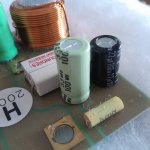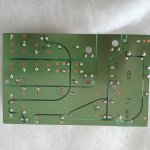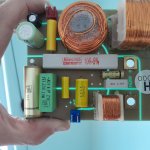Hi everyone, I have purchased a pair of these Chario speakers for a few bucks, and they seem very well made, but the sound is not forward enough in the midband and high frequencies for my liking. I have ascertained that the present crossover splits between bass and tweeter at 1400hz , which seems very low to me.
I have replaced the existing (Danish) tweeters with the more expensive 9300/2905 scanspeak which I happened to have, similar result so the tweeters must be similar efficiency.
I want to understand two things :
1. What crossover component must I change to bring the crossover point to say 2500hz ?
2. What components of the crossover are likely to be flattening the bass unit response, I would like to make it more lively ?
I attach photos of crossover, which is split for bi-wiring, so I guess should be easier for an expert to see what changes could be considered.
This is just a project, so am not too concerned if the first attempt doesn't work !
I have replaced the existing (Danish) tweeters with the more expensive 9300/2905 scanspeak which I happened to have, similar result so the tweeters must be similar efficiency.
I want to understand two things :
1. What crossover component must I change to bring the crossover point to say 2500hz ?
2. What components of the crossover are likely to be flattening the bass unit response, I would like to make it more lively ?
I attach photos of crossover, which is split for bi-wiring, so I guess should be easier for an expert to see what changes could be considered.
This is just a project, so am not too concerned if the first attempt doesn't work !
Attachments
-
 WhatsApp Image 2024-01-23 at 13.33.29.jpeg288.8 KB · Views: 256
WhatsApp Image 2024-01-23 at 13.33.29.jpeg288.8 KB · Views: 256 -
 WhatsApp Image 2024-01-23 at 13.32.15.jpeg168.3 KB · Views: 197
WhatsApp Image 2024-01-23 at 13.32.15.jpeg168.3 KB · Views: 197 -
 WhatsApp Image 2024-01-23 at 13.31.47.jpeg181.2 KB · Views: 155
WhatsApp Image 2024-01-23 at 13.31.47.jpeg181.2 KB · Views: 155 -
 WhatsApp Image 2024-01-23 at 13.31.09.jpeg244.8 KB · Views: 155
WhatsApp Image 2024-01-23 at 13.31.09.jpeg244.8 KB · Views: 155 -
 WhatsApp Image 2024-01-23 at 13.30.31.jpeg193.1 KB · Views: 164
WhatsApp Image 2024-01-23 at 13.30.31.jpeg193.1 KB · Views: 164 -
 WhatsApp Image 2024-01-23 at 13.30.06.jpeg206.9 KB · Views: 200
WhatsApp Image 2024-01-23 at 13.30.06.jpeg206.9 KB · Views: 200
You may be best starting with an equaliser, and not touching the crossover. Also work out the issue of placement within the room.
You have asked a lot of difficult questions that probably no one has an answer to, unless they have already done corrections on that same speaker. You changed the tweeters, it's not that speaker anymore.
Now you have to get or borrow measuring equipment, copy the schematic from that factory crossover, do a series of speaker measurements and based on that start slowly with crossover corrections while constantly measuring the results, until you get what you want. And if you also change the crossover frequency, that's practically creating a new crossover.
Now you have to get or borrow measuring equipment, copy the schematic from that factory crossover, do a series of speaker measurements and based on that start slowly with crossover corrections while constantly measuring the results, until you get what you want. And if you also change the crossover frequency, that's practically creating a new crossover.
Maybe it would be easier to make a new crossover, after all the Scanspeak 9300/2905 parameters are well known, and I would guess that the bass/midrange unit is a 6.5inch, 4 ohm, so perhaps it would be better just to bite the bullet and try a new design, there do seem to be an awful lot of inductors in the existing circuit, perhaps something much simpler could produce the starting point for the new crossover ? Any advice or comments would be welcome, as I get the sense that the woofer circuit has been tailored to produce a very distinct (to my ears muffled) type of response.
I should mention that I do not have an equaliser, nor measuring equipment, so really have to do this based on the known parameters of the tweeter combined with guesswork for the woofer ; not ideal I know, but if anyone has any ideas as to what a simple second order crossover could look like that would greatly assist.
Attachments
https://audio.com.pl/testy/stereo/kolumny-glosnikowe/241-chario-hiper-2000-t-mkii
Here is one of their models. Yours may be similar, but it doesn't have to be. You will have to do everything from the beginning, with measurements. You have as many calculators for theoretical crossover as you want. Of course, it will certainly not work for those particular speakers.
Here is one of their models. Yours may be similar, but it doesn't have to be. You will have to do everything from the beginning, with measurements. You have as many calculators for theoretical crossover as you want. Of course, it will certainly not work for those particular speakers.
Hmm, the dip between 2.5khz and 5khz is most probably what I am hearing (or rather not hearing), and this seems to be a bit of a house trait ? My speaker is like the first one Hiper-2000 but not the floorstanding version but the bookshelf. That frequency response curve looks about what I have observed though.
Thank you for these links, very interesting.
Thank you for these links, very interesting.
It seems that they make everything with such a frequency range. Sit down and slowly draw that crossover, reverse engineer it.
An old trick, connect several different cheap capacitors in parallel to get one "better sounding capacitor". I don't think it can replace a quality capacitor, it's just cheaper. And even when there is a larger capacitor, as here, you often have no choice but to put several smaller ones in parallel. That's not the problem here, it's the weird frequency range they design.
Hmmm, now I see the two parallelled 0.68 and 0.82 caps, paralleled to the 10 Ω resistor, yes, that's a trick for raising the treble, but still the different caps are strange...and out of range. Then there's the bunch of caps...never seen that!
So where else is the problem?!
So where else is the problem?!
- Home
- Loudspeakers
- Multi-Way
- Chario Hyper 2000 crossover